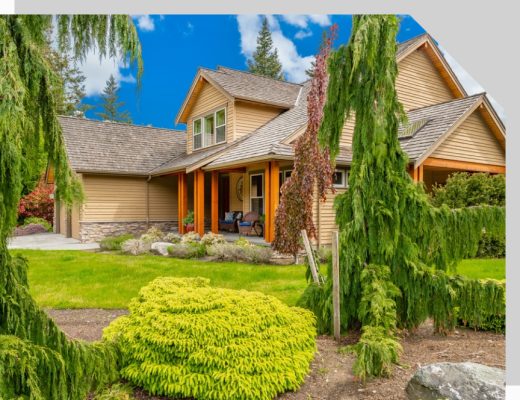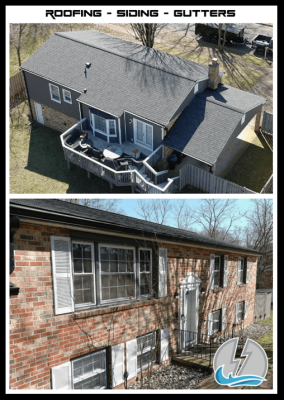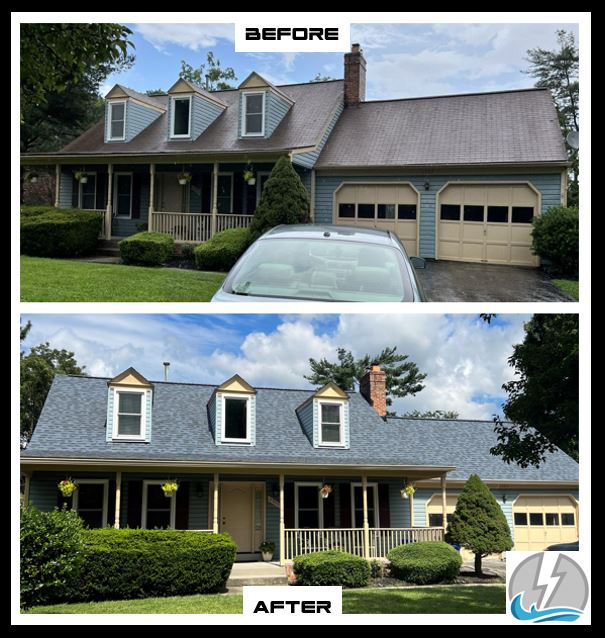Discover The Beauty of Wood Siding with Our Siding Contractors
Are you looking for exterior siding options in Maryland that combine natural looks with time-tested durability and eco-friendliness? Our Edgewater roofing contractors at Thunder Bay Roofing have various siding options for homeowners looking for a natural, rustic look for their home’s exterior.
Find out more about wood siding and if it’s best for your property with our comprehensive guide, or call our Anne Arundel County roofing company by dialing 410-956-7663.

What Is Wood Siding?
Wood siding is a cladding material made from different types of wood, including faux wood. It’s installed horizontally or vertically on the exterior walls of a house and is available in a variety of styles. The type of wood used, as well as the style and installation method, can greatly benefit the overall aesthetic of the house, making wood siding a popular choice for homeowners in Edgewater and surrounding areas looking to enhance their curb appeal.
Types of Wood Siding
Cedar Siding
Cedar siding is a durable and insect-resistant option that comes in different grades, textures, and colors. Its natural oils and preservatives make it resistant to damage from the elements, including the humid climate of the Chesapeake Bay area. This versatility makes it a popular choice among Edgewater homeowners who want a long-lasting and visually appealing exterior.
Clapboard Siding
Clapboard, or lap siding, consists of long horizontal planks that overlap each other. This style creates a clean, uniform look that is both traditional and modern, depending on the type of wood and finish. Clapboard is often made from cedar, pine, or redwood, all of which offer excellent durability and weather resistance.
Shingle Siding
Shingle siding, also known as shake siding, features thin, flat pieces of wood that are applied in an overlapping pattern. This creates a textured, rustic appearance that adds charm and character to any home. Cedar is the most popular choice for shingles due to its resistance to moisture, decay, and insects.
Board and Batten Siding
Board and batten siding involves wide vertical boards that are joined by thin strips of wood, called battens, to cover the seams. This style is a favorite for homes looking to achieve a farmhouse or country aesthetic. Board and batten siding provides a bold, geometric design that enhances the visual interest of any exterior.
Log Siding
Log siding mimics the appearance of a log cabin, providing a rustic and natural look. It’s typically made from half logs that are installed horizontally. Log siding can give your home the cozy, cabin-like charm associated with rural settings while providing modern insulation and protection.

Benefits of Wood Siding
Wood siding has been around for hundreds of years and has become largely popular due to the time-tested benefits it provides. Some of the benefits of wood siding include:
- Natural Beauty: Wood siding adds a natural and rustic look to an Edgewater home’s exterior, enhancing its curb appeal and value.
- Insulation: Wood siding has natural insulating properties, which can help reduce energy costs and improve indoor comfort, especially during Maryland’s hot summers and cold winters.
- Durability: High-quality wood siding can last for many years with proper maintenance and care, standing up to the Chesapeake Bay area’s diverse weather conditions.
- Sustainability: Wood is a renewable resource, making it an eco-friendly choice for Edgewater homeowners who want to minimize their environmental impact. Additionally, wood is biodegradable, meaning it can be recycled and repurposed, further reducing its environmental impact.
- Customizability: Wood siding comes in various species, grades, textures, and finishes, allowing Edgewater homeowners and property owners to customize their home’s exterior to fit their design preferences and budget. Whether you choose tongue and groove siding or split log siding, you can achieve your vision.
- Timelessness: Wood siding has been used for centuries and has stood the test of time as a classic and enduring option for home exteriors. Its natural beauty and durability have made it a popular choice among homeowners in Edgewater and beyond for generations.
Disadvantages of Wood Siding
While wood siding is an attractive, sturdy siding option, it’s not for everybody. Keep the possible disadvantages of wood siding in mind when making your decision:
- Requires More Frequent Maintenance: Wood siding needs to be regularly cleaned, sealed, and stained or painted to maintain its appearance and protect it from the elements, especially in Edgewater’s humid climate. Failure to do so can result in damage and premature aging of the wood.
- Attracts Insects: Wood siding can attract insects, such as termites and carpenter ants, which can cause significant damage if left untreated. This can be particularly problematic in Edgewater’s warm, moist environment.
- Fire Hazard: Wood siding is combustible, which means it can pose a fire hazard if it’s exposed to flames or embers. This can be a concern for homes with wood-burning appliances or in areas prone to brush fires.
- Higher Cost: Wood siding can be more expensive than other materials, such as vinyl or fiber cement, which can be a barrier to homeowners on a tight budget.
- Limited Color Options: While wood siding can be stained or painted in a variety of colors, the natural color of the wood is limited to shades of brown, red, and yellow, which may not be suitable for all design aesthetics.
- Not Suitable for All Climates: While Edgewater’s climate is generally suitable for wood siding, areas with high humidity, frequent rain, or extreme temperature fluctuations may accelerate damage and decay.
Homes Best Suited for Wood Siding
Traditional Homes
Wood siding is a great option for properties in Edgewater that have a traditional or rustic style. It can also be used on modern properties to add warmth and texture.
Homes in Dry Areas
While Edgewater has a humid climate, wood siding can still be a good option with proper maintenance. Our siding professionals at Thunder Bay Roofing can advise on the best types of wood and treatments for the local climate.
Eco-Friendly Homes
Wood siding is a renewable and sustainable material, making it a good option for eco-friendly or green homes and properties in Edgewater and surrounding areas.
Homes in Loud Areas
Wood siding is good for homes and properties owned by people with sensitivity to loud noises. It can also help reduce noise pollution because it has natural sound-dampening properties, which can be beneficial in busier parts of Edgewater or near major roads.

Factors That Influence Wood Siding Costs
As with other siding options, certain factors will influence the cost of your wood siding in Edgewater:
- Wood Species: The cost of wood siding can vary greatly depending on the type of wood used. Softwoods such as pine or cedar tend to be less expensive, while hardwoods such as mahogany or teak can be more costly.
- Grade of Wood: The grade of wood used for the siding can also affect the cost. Higher-grade woods are more uniform and have even grain and fewer knots or blemishes, making them more expensive.
- Siding Style: The style of wood siding chosen can impact the cost. Traditional clapboard or board-and-batten styles tend to be less expensive, while more complex styles such as shingles or shakes can be more expensive.
- Finish: The type of finish applied to the wood siding can also influence the cost. Stains tend to be less expensive than paints but can require more frequent maintenance, especially in Edgewater’s climate.
- Labor Costs: The cost of labor for installation can vary depending on the complexity of the project. At Thunder Bay Roofing, our experienced team ensures efficient and high-quality installation.
- Location: The location of the home in Edgewater or surrounding areas can affect the cost of wood siding. Factors like accessibility and local building codes may impact the overall price.
- Maintenance: The long-term cost of wood siding also typically includes maintenance expenses. Regular painting or staining, as well as repairs or replacements due to damage or decay, should be factored into the overall cost.
Installing Wood Siding
At Thunder Bay Roofing, our team follows these steps when installing wood siding:
- Clean, dry, and clear debris from the surface where the wood siding will be installed.
- Apply a layer of moisture barrier, such as house wrap, over the surface to protect against water damage, which is crucial in Edgewater’s humid climate.
- Create a layout for the wood siding to determine the best placement and alignment.
- Measure and mark the wall to ensure proper spacing and symmetry.
- Install the starter strip along the bottom of the wall, ensuring it is level and straight.
- Install the first course of wood siding, ensuring it’s level and aligned with the starter strip. Nail the siding into place using galvanized nails or screws.
- Install the remaining courses of wood siding, ensuring each course is level and aligned with the previous one.
- Use a saw or snips to cut the siding to fit around windows, doors, and other obstacles.
- Install trim pieces, such as corner boards and window casings, to complete the look of the wood siding.
- Allow the wood siding to dry completely before applying any sealant or protective coating.
- Apply a sealant or protective coating to the wood siding to help protect it from water damage and weathering, which is particularly important in Edgewater’s climate.
Wood Siding Maintenance
As with most exterior siding options, wood siding will require regular maintenance to stay beautiful and strong. Our roofing contractors at Thunder Bay Roofing recommend these tips for maintaining wood siding in Edgewater:
- Regularly clean the surface of the wood siding with a soft-bristled brush or a low-pressure power washer to remove dirt, debris, and mildew, which can be more prevalent in Edgewater’s humid climate.
- Inspect the wood siding for any signs of damage, such as cracks, splits, or rot.
- Replace or repair any damaged boards as soon as possible to prevent further issues.
- Keep trees and shrubs trimmed away from the wood siding to prevent moisture buildup and insect infestations.
- Apply a high-quality wood preservative or stain to the siding every three to five years to protect it from the elements and prevent fading, especially important in Edgewater’s sunny climate.
- Check the caulking and sealant around windows, doors, and other penetrations in the siding, and reapply as needed to prevent water intrusion.
- Make sure the gutters and downspouts are clear of debris and functioning properly to prevent water from backing up and damaging the siding.
- Keep the wood siding dry by ensuring it has adequate ventilation and that any moisture sources (such as sprinklers) are not directed at the siding.
- Consider installing a vapor barrier or insulation behind the wood siding to prevent moisture buildup and improve energy efficiency.
Frequently Asked Questions
Generally, high-quality wood siding can last for up to 30 years or more with proper care. However, the lifespan of wood siding depends on the type of wood used and the level of maintenance it receives.
Yes, wood siding can be painted or stained to match a home’s design and color scheme. However, it requires regular maintenance to prevent chipping, peeling, or fading, especially in variable weather conditions.
Wood siding is a renewable resource, making it an eco-friendly choice for homeowners. However, it requires harvesting and processing, which can have an impact on the environment. Choosing sustainably harvested wood and using eco-friendly finishes can help reduce the environmental impact of wood siding.
The frequency of painting or staining wood siding depends on the type of wood, climate, and maintenance. In humid climates, it’s generally recommended to repaint or restain every three to five years to maintain its appearance and protect it from damage.
